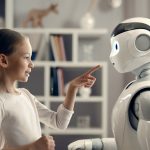Another piece of the AGI story is the string of AGI breakthroughs that made artificial general intelligence feel less like a distant dream and more like an approaching reality.
Each of these milestones not only grabbed media attention but also hit home personally. People began to see that AGI wasn’t just theoretical anymore. It was real. And it was starting to reshape our lives.
Let’s recap some major advances between 2022 and 2025 that fueled the AGI surge, and explore what they meant for ordinary people.
The generative AI explosion
The launch of generative AI (Gen AI) tools like ChatGPT-3.5 and GPT-4 marked a tipping point in the eyes of many. As if overnight, we woke up to the realization that AI could write essays, draft code, analyze websites and hold lifelike conversations.
Chat wasn’t just better—it was eerily capable across a range of disciplines.
GPT-4, for instance, passed the bar exam, scored in the 90th percentile on the SAT, and could generate functional software, all from natural language prompts entered by its users. For students, programmers, marketers and writers, this startling advancement was thrilling but also quite unsettling. We began asking questions like: Is this the birth of a tool that will eventually be able to do any job?
GPT-4’s jaw-dropping versatility led some researchers to suggest the AI showed early signs of general intelligence. Professionals began to wonder whether AI would become their collaborator—or competitor. No wonder public interest in AGI began to explode.
Multimodal and agentic AI arrives
In 2023 and 2024, AI’s capabilities expanded even further. Models no longer worked with just text. They became multimodal—able to process not only language, but also images, audio, and more.
OpenAI added vision to GPT-4, allowing users to upload photos or screenshots and receive intelligent responses based on visual input. For example, a user could take a picture of a broken appliance, and GPT-4 could help identify the model and suggest possible fixes. It could also interpret graphs, solve handwritten math problems, or describe the contents of a scene in detail—tasks that once required human eyes and insight.
Google’s Gemini, meanwhile, launched with multimodal abilities from day one. Its capabilities include:
- Text understanding and generation
- Image analysis (e.g., describing a painting or detecting patterns in a chart)
- Speech recognition and synthesis (hearing and speaking responses)
- Code understanding and generation
- Video interpretation (such as summarizing or responding to visual content in motion)
This meant AI could “see” as well as read and write. It could describe photos, analyze charts, understand spoken questions and generate captions. As these were skills once reserved for people, lots of people took notice. Again, almost in the blink of an eye, AI could now not only read the world’s information but could now observe and interpret it.
Meanwhile, the idea of autonomous AI agents gained traction. In early experiments, such as AutoGPT, AIs began to be able to chain tasks together and semi-independently act/ By late 2024, Google CEO Sundar Pichai spoke openly about an “agentic era” in which assistants wouldn’t just respond to commands, but take initiative.
This development raised both exciting and uneasy possibilities: What happens when your AI assistant can schedule appointments, manage tasks, and handle entire projects without you having to ask it twice?
Robots in the real world: AGI breakthroughs to watch
While most headlines focused on software, the hardware side of AI leaped forward. In factories and warehouses, AI-powered robots became more capable and autonomous.
Amazon’s warehouse bots and Waymo’s driverless cars are two visible examples. In some cities, autonomous vehicles are already operating with no safety driver on board.
Although no robot in 2025 can yet pass the so-called “Coffee Test”—the idea that true AGI would be able to enter a stranger’s home and make a cup of coffee—progress is measurable. AI-guided machines can now navigate complex spaces, assemble furniture and even pilot drones. The bottom line is robots are inching from novelty to necessity, helped by AGI breakthroughs that make them easier to work with.
Yes, these advances promised convenience and productivity. But they also sparked concern about automation creeping into both manual labor and skilled trades.
Creativity and science breakthroughs
Perhaps most strikingly, AI began encroaching on what many considered the final frontier of human uniqueness: creativity and innovation.
By 2023, AI-generated art and music were winning public attention, and even awards. More importantly, AI began contributing to science. AlphaFold cracked protein-folding problems. Other systems proposed new mathematical theorems or designed novel molecules.
By 2023, AI-generated art and music were winning public attention—and even awards. But more importantly, AI began contributing to science in meaningful ways. One of the most celebrated breakthroughs came from AlphaFold, developed by Google DeepMind.
AlphaFold solved one of biology’s grand challenges: predicting how proteins fold into their 3D shapes. Proteins are the tiny machines inside every cell, and their function depends entirely on their shape. Figuring out that shape from a protein’s genetic code used to take scientists months or years in the lab. AlphaFold changed that. It could predict the structure of a protein in hours with astonishing accuracy, based purely on its amino acid sequence.
By 2023, AlphaFold had mapped more than 200 million proteins, which covers nearly every organism known to science. Researchers around the world began using these predictions to accelerate drug discovery, understand diseases, and engineer enzymes for everything from cancer treatment to plastic breakdown.
DeepMind has since been working on expanding AlphaFold’s abilities, such as predicting how proteins interact with each other, how mutations affect protein behavior, and even how entire protein complexes assemble and function inside cells. These steps bring AI deeper into molecular biology, not just predicting structures but helping design entirely new biological tools.
Meanwhile, other AI systems proposed novel mathematical theorems or designed new molecules—marking the start of a new era in machine-assisted discovery.
These developments chipped away at the idea that only human intelligence can be creative or inventive. For many, this was deeply personal. If creativity and scientific discovery are no longer exclusively human traits, what does that mean for our role in the world?
Some people were inspired. They imagine AI accelerating progress in medicine, energy and design. Others were unnerved by the idea of machines entering the sacred space of imagination and insight.
AGI breakthroughs: from theory to practical applications
In the span of just a few years, AI ticked off multiple boxes on the AGI checklist. It became more general-purpose, more autonomous, more embodied and more creative. With each leap forward, interest in AGI surged.
And crucially, these shifts didn’t stay theoretical. Individuals began to feel them. From autocomplete in your email to an AI-generated song in your feed—or a friend losing a job to automation—people started experiencing the tremors of a coming quake.
AGI stopped being an abstract concept. It became a trend worth tracking. Because it was no longer about if it would affect your life, but how soon.
FAQS
Q1. What are the biggest AGI breakthroughs since 2022?
ChatGPT’s public launch, GPT-4-level reasoning, multimodal and agentic systems, GPT-5’s advances in medical information, coding, hallucination reduction, AlphaFold’s impact on biology, and steady gains in real-world robotics.
Q2. What does “multimodal” and “agentic” mean?
Multimodal models handle text plus images, audio, or video. Agentic tools can plan and take sequences of actions toward a goal.
Q3. Are robots close to passing everyday tests?
They’re improving in warehouses and on roads, but generalized “walk into a kitchen and make coffee” capability is still hard.
Q4. What changed for everyday people?
Accessible chat interfaces, better writing, and faster creative workflows made AI more practical and useful, not just impressive.






Leave a Reply